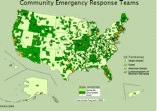Starting a CERT Program
Step 1: Assessing Needs
Words of Advice: Tips for Assessing Needs
Joe Lowry - Memphis, Tennessee
Assess Risks and Develop a Plan
Make sure you do a risk assessment, look at the events that could possibly affect your community, and then use that as a starting point for teaching citizens how to prepare themselves to survive.
Community demographics are very important to consider when planning a CERT program. A great benefit to the program is knowing the people and their vocation so that you know who you can count on for CERT resources and community volunteers.
Develop a written response plan. A written plan enables the team to become a self-sustaining entity even after the team's founders have moved away from the neighborhood. A written plan also allows the team to respond effectively if the team's leaders are unable to respond. Any team member should be able to open the plan and implement it.
Don't limit yourself. Look at the resources you have available and utilize them. Undeniably the program evolves: if people stay with the program and identify with it, it takes on a life of its own. If you stick to the rigid idea of the class itself you're limiting yourself.

Rachel Jacky - Portland, Oregon
Begin By Setting Goals
Spend time up front to figure out what your needs are and how you're going to address those needs.
It may be tempting to simply start training teams with the material available from FEMA, but it's good to spend some time figuring out your program goals and how you'll address those goals.
There are a number of groups (for example, neighborhood associations, fire department, law enforcement, and transportation department) in any community for whom the CERTs could be a real resource. And, there may be other groups who aren't sure about the CERT model. It's good to talk with representatives of all of these groups when setting program goals.
Joe Lowry - Memphis, Tennessee
Consider Hazards, Communications, and Logistics
It is so very important to consider the hazards that are possible within the community and then plan accordingly. Recognize all of the variables that can take place during the event of a specific emergency and then set your goals around these variables and possibilities.
It is important to consider the communications available within the community. Communications is such an integral part of the program and knowing the community's capabilities is a critical first step.
All the logistical aspects of the community response must be considered when setting goals for the CERT program. These logistics play a key role in what can be utilized during an emergency situation.
Your CERT plan should have non-emergency as well as emergency functions, a commitment to continuing education, and strategy for sustaining the program.

Dale Kleos - Whatcom County, Washington
Allow for Growth
Don't be afraid to let your CERT program develop at the hands of its volunteers. As your program evolves it will take on a life of its own. If people stay with the program and identify with it, then they will have ideas for improving it. Don't be limited by your original plan.

Frank Lucier - San Francisco, California
Determine Deployment Procedures
It's important to first decide how CERT teams will operate in a real disaster prior to starting the program. What will cause them to self-activate? How will they be called up? What will be their area of responsibility? How will they communicate with emergency services? Get the operational questions answered.
Start small! Make your goals achievable. The program will take on a life of its own once it's up and running. Make sure that the start-up phase is manageable.


